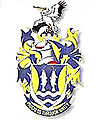Hentiesbaai
|
Henties Bay Afrikaans: Hentiesbaai German: Hentiesbucht |
||
|---|---|---|
| City | ||
 |
||
|
||
| Coordinates: 22°07′06″S 14°16′57″E / 22.1184°S 14.2824°E | ||
| Country |
|
|
| Region | Erongo Region | |
| Constituency | Arandis Constituency | |
| Established | 1929 | |
| Government | ||
| • Mayor | Aila Haufiku | |
| Population (2015) | ||
| • Total | 8,000–10,000 (seasonal) |
|
| Climate | BWk | |
Henties Bay (English, literally: Henty's Bay. Afrikaans: Hentiesbaai, German: Hentiesbucht) is a coastal city in the Erongo Region of western Namibia. It is located 70 km north of Swakopmund and is an important holiday settlement. 70 kilometres to the north of the town is the seal colony of Cape Cross. The town has about 8,000 inhabitants (10,000 during the holiday season) and owns 121 square kilometres (47 sq mi) of land. The mayor of Henties Bay is Aila Haufiku.
Bartolomeu Dias sailed along the Atlantic coast in 1488. Near the area of today's Henties Bay he discovered such an abundance of fish that he named this coastline Praia das Sardinhas, Coast of Fish. The fresh water source was first discovered by Schutztruppe soldiers in 1886. In 1920, a minerals prospector stayed overnight. After tasting the water he was said to be healed from an affliction.
The namesake of the town is major Hendrik "Henty" Stefanus van der Merwe who discovered the place in 1929 while looking for water. He had been hunting a rhinoceros in the arid hinterland of the Namibian coast near the Brandberg in order to collect a reward from a museum in Pennsylvania that was in search of a rhino skeleton. After shooting the rhino and scraping meat from the bones, water resources of the expedition diminished and forced the party to load the decomposing carcass and search for water.
They chose to head into the direction of the Atlantic coast and reached it close to Cape Cross. From there van der Merwe and his fellows searched southwards for the mouth of Omaruru River. A few miles south of the mouth they discovered a deep sand valley with reed grass growing in it, advertising the presence of fresh water. Van der Merwe liked the place and after delivering the bones and collecting his reward, returned the following Christmas to build a wooden hut in the riverbed. The place became known as Henty se baai (Henty's Bay) and developed into a holiday hideout, mainly because of the abundance of fish at this spot.
...
Wikipedia


